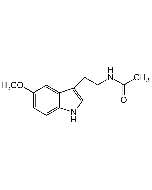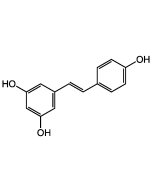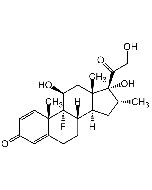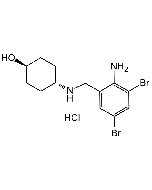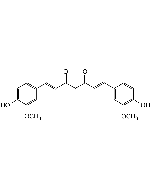Cookie Policy: This site uses cookies to improve your experience. You can find out more about our use of cookies in our Privacy Policy. By continuing to browse this site you agree to our use of cookies.
Innaxon
Curcumin (high purity) Sterile Solution
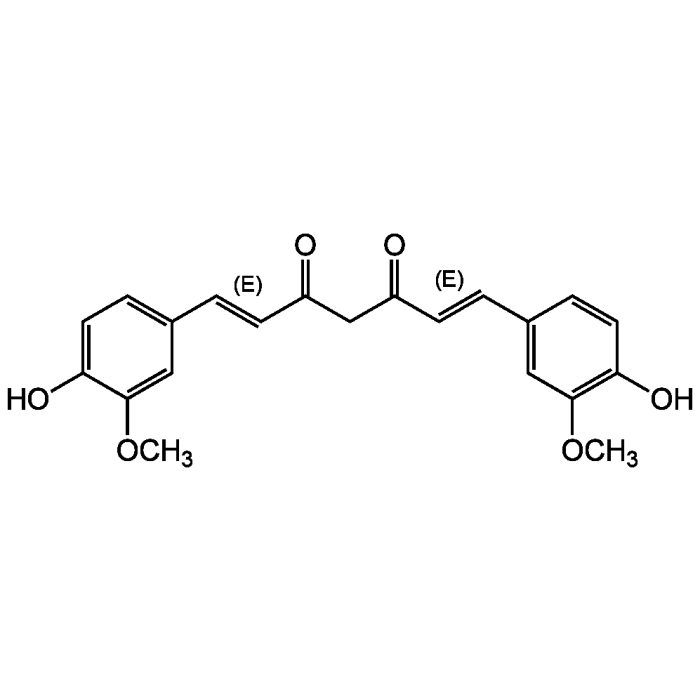
| Product Details | |
|---|---|
| Synonyms | Curcumin (high purity) Lipodisq™ Sterile Solution; BRN 2306965; CCRIS 3257; NSC 32982; NSC 687842; CI 75300; 1,7-bis(4-hydroxy-3-methoxyphenyl)hepta-1,6-diene-3,5-dione, diferuloylmethane |
| Product Type | Chemical |
| Properties | |
| Formula |
C21H20O6 |
| MW | 368.4 |
| CAS | 458-37-7 |
| RTECS | MI5230000 |
| Source/Host Chemicals | Synthetic. Originally isolated from turmeric (Curcuma longa). |
| Purity Chemicals | ≥95% (HPLC) |
| Purity Detail | Free of demethoxy- and bis-demethoxycurcumin. Curcumin in Lipodisq does not contain any bioactive impurities (usually present in up to 40% in natural formulations of curcumin). |
| Appearance | Orange clear aqueous solution. |
| Solubility | Soluble in water, PBS, Tris and other physiological solutions as formulated in a proprietary, thermostable, aqueous lipid nanoparticulate formulation (Lipodisq). |
| Reconstitution | Avoid the use of buffers with divalent ions such as Ca or Mg or pH <6.5 or >8.0, which can cause particle instability. |
| Formulation | Liquid, detergent-free discoidal nano-formulation made of styrene-maleic acid lipid particles (SMALP), lecithin and sterile water. |
| Concentration | 1mg/ml (0.1% w/vol) Curcumin in Lipodisq corresponds to 271.7uM solution. |
| Biological Activity |
Discoidal nano-particles can incorporate hydrophobic, poorly water-soluble compounds, such as lipids, lipoproteins and glycolipids. - Cell culture tested (human macrophage cell line) (MTT). - Recommended starting dilution: 1:200 or higher. - Optimal working concentrations depend on the applications and need to be determined. - Published procedures using Lipodisq formulations (Curcumin and IAXO TLR4 antagonists) in vivo rodent models at 3-10mg/kg. Recommended route of administration is subcutaneous (s.c.) with oral or nasal application as a possible alternative, which needs to be optimized. |
| Declaration | Manufactured by Innaxon. |
| Other Product Data |
Note: This highly purified product is free of demethoxy- and bis-demethoxycurcumin and does not contain 30-40% bioactive impurities. Click here for Original Manufacturer Product Datasheet: Our product description may differ slightly from the original manufacturers product datasheet.
|
| InChi Key | VFLDPWHFBUODDF-FCXRPNKRSA-N |
| Smiles | COC1=CC(\C=C\C(=O)CC(=O)\C=C\C2=CC(OC)=C(O)C=C2)=CC=C1O |
| Shipping and Handling | |
| Shipping | AMBIENT |
| Short Term Storage | +4°C |
| Long Term Storage | +4°C |
| Handling Advice |
Keep sterile. Protect from light. Avoid skin and eye contact. |
| Use/Stability | Stable for at least 1 year after receipt when stored at +4°C. |
| Documents | |
| MSDS |
 Download PDF Download PDF |
| Product Specification Sheet | |
| Datasheet |
 Download PDF Download PDF |
- Curcumin (high purity) Sterile Solution is a ready-to-use nano-formulated aqueous solution.
- Curcumin is a yellow pigment present in the spice turmeric (Curcuma longa) that has been associated with anti-oxidant, anti-inflammatory, anti-cancer, anti-viral and anti-bacterial activities [1-20]. However, curcumin shows poor absorption, biodistribution, metabolism and bioavailability. To increase the bioavailability, enhance circulation, improve permeability and resistance to metabolic processing several formulations of curcumin have been prepared which include nanoparticles, liposomes, micelles and phospholipid complexes [21-25].
- Curcumin (high purity) Lipodisq is based on a nanoparticle (11-40nm) drug delivery system comprising a discoidal phospholipid bilayer membrane stabilized by a chaperone molecule annulus. Internal properties of the phospholipid membrane support the disposition and stabilization of drug molecule candidates and preserve the native conformation of membrane molecules. The resulting encapsulated actives are rendered water-soluble and specialized for intra-cellular penetration/delivery via endosomal uptake mechanisms. Lipodisq solutions show a good safety profile and are suitable for in vitro and in vivo investigations.
- Anticancer potential of curcumin: preclinical and clinical studies: B.B. Aggarwal, et al.; Anticancer Res. 23, 363 (2003) (Review)
- Multiple biological activities of curcumin: a short review: R.K. Maheshwari, et al.; Life Sci. 78, 2081 (2006) (Review)
- Antioxidant and anti-inflammatory properties of curcumin: V.P. Menon & A.R. Sudheer; Adv. Exp. Med. Biol. 595, 105 (2007) (Review)
- Antitumor, anti-invasion, and antimetastatic effects of curcumin: G. Kuttan, et al.; Adv. Exp. Med. Biol. 595, 173 (2007) (Review)
- Neuroprotective effects of curcumin: G.M. Cole, et al.; Adv. Exp. Med. Biol. 595, 197 (2007) (Review)
- Potential therapeutic effects of curcumin, the anti-inflammatory agent, against neurodegenerative, cardiovascular, pulmonary, metabolic, autoimmune and neoplastic diseases: B.B. Aggarwal & K.B. Harikumar; Int. J. Biochem. Cell Biol. 41, 40 (2009) (Review)
- Targeting inflammation-induced obesity and metabolic diseases by curcumin and other nutraceuticals: B.B. Aggarwal; Annu. Rev. Nutr. 30, 173 (2010) (Review)
- Development of curcumin as an epigenetic agent: S. Fu & R. Kurzrock; Cancer 116, 4670 (2010) (Review)
- The role of nutraceuticals in the regulation of Wnt and Hedgehog signaling in cancer: F.H. Sarkar, et al.; Cancer Metastasis Rev. 29, 383 (2010) (Review)
- Curcumin and obesity: evidence and mechanisms: L. Alappat & A.B. Awad; Nutr. Rev. 68, 729 (2010) (Review)
- Curcumin: a potential neuroprotective agent in Parkinson's disease: R.B. Mythri & M.M. Bharath; Curr. Pharm. Des. 18, 91 (2012) (Review)
- Targeting proteasomal pathways by dietary curcumin for cancer prevention and treatment: N. Hasima & B.B. Aggarwal; Curr. Med. Chem. 21, 1583 (2014)
- Curcumin as a MicroRNA Regulator in Cancer: A Review: A.A. Momtazi, et al.; Rev. Physiol. Biochem. Pharmacol. 171, 1 (2016) (Review)
- Curcumin: a modulator of inflammatory signaling pathways in the immune system: K.R. Kahkhaie, et al.; Inflammopharmacol. 27, 885 (2019) (Review)
- Antidiabetic Properties of Curcumin I: Evidence from In Vitro Studies: D.J.Den Hartogh, et al.; Nutrients 12, 118 (2020) (Review)
- Antidiabetic Properties of Curcumin II: Evidence from In Vivo Studies: D.J.Den Hartogh, et al.; Nutrients 12, 58 (2020) (Review)
- The Emerging Role of Curcumin in the Modulation of TLR-4 Signaling Pathway: Focus on Neuroprotective and Anti-Rheumatic Properties: M.A. Panaro, et al.; Int. J. Mol. Sci. 21, 2299 (2020) (Review)
- Curcumin as an Antiviral Agent: M.R. Jennings & R.J. Parks; Viruses 12, 1242 (2020) (Review)
- COVID-19: A Case for Inhibiting NLRP3 Inflammasome, Suppression of Inflammation with Curcumin? A.Saeedi-Boroujeni, et al.; Basic. Clin. Pharmacol. Toxicol. 128, 37 (2021) (Review)
- Curcumin and Biochemical Parameters in Metabolic-Associated Fatty Liver Disease (MAFLD): G. Rozanski, et al.; Nutrients 13, 2654 (2021)
- Formulation, characterization and evaluation of curcumin-loaded PLGA nanospheres for cancer therapy: A. Mukerjee & J.K. Vishwanatha; Anticancer Res. 29, 3867 (2009)
- Curcumin-decorated nanoliposomes with very high affinity for amyloid-beta1-42 peptide: S. Mourtas, et al.; Biomaterials 32, 1635 (2011)
- Novel lipid based oral formulation of curcumin: development and optimization by design of experiments approach: Y.B. Pawar, et al.; Int. J. Pharm. 436, 617 (2012)
- Purely aqueous PLGA nanoparticulate formulations of curcumin exhibit enhanced anticancer activity with dependence on the combination of the carrier: K.L. Nair, et al.; Int. J. Pharm. 425, 44 (2012)
- Anti-inflammatory activity of curcumin-loaded solid lipid nanoparticles in IL-1beta transgenic mice subjected to the lipopolysaccharide-induced sepsis: J. Wang, et al.; Biomaterials 53, 475 (2015)
General References for Lipodisq™ Technology:
- Responsive Hydrophobically Associating Polymers: A Review of Structure and Properties: S.R. Tonge & B.J. Tighe; Adv. Drug Deliv. Rev. 53, 109 (2001)
- Detergent-free formation and physico-chemical characterization of nanosized lipidpolymer complexes: Lipodisq; M.C. Orwick, et al.; Angew. Chem. 51, 4653 (2012)
- Physicochemical Characterization, Toxicity and In Vivo Biodistribution Studies of a Discoidal, Lipid-Based Drug Delivery Vehicle: Lipodisq Nanoparticles Containing Doxorubicin: M.L. Torgersen, et al.; J. Biomed. Nanotechnol. 16, 41 (2020)
- Applications of Synthetic Polymer Discoidal Lipid Nanoparticles to Biomedical Research: M. Tanaka; Chem. Pharm. Bull. 70, 507 (2022)
- Mechanisms of Formation, Structure, and Dynamics of Lipoprotein Discs Stabilized by Amphiphilic Copolymers: A Comprehensive Review: P.S. Orekhov, et al.; Nanomaterials 12, 361 (2022)








